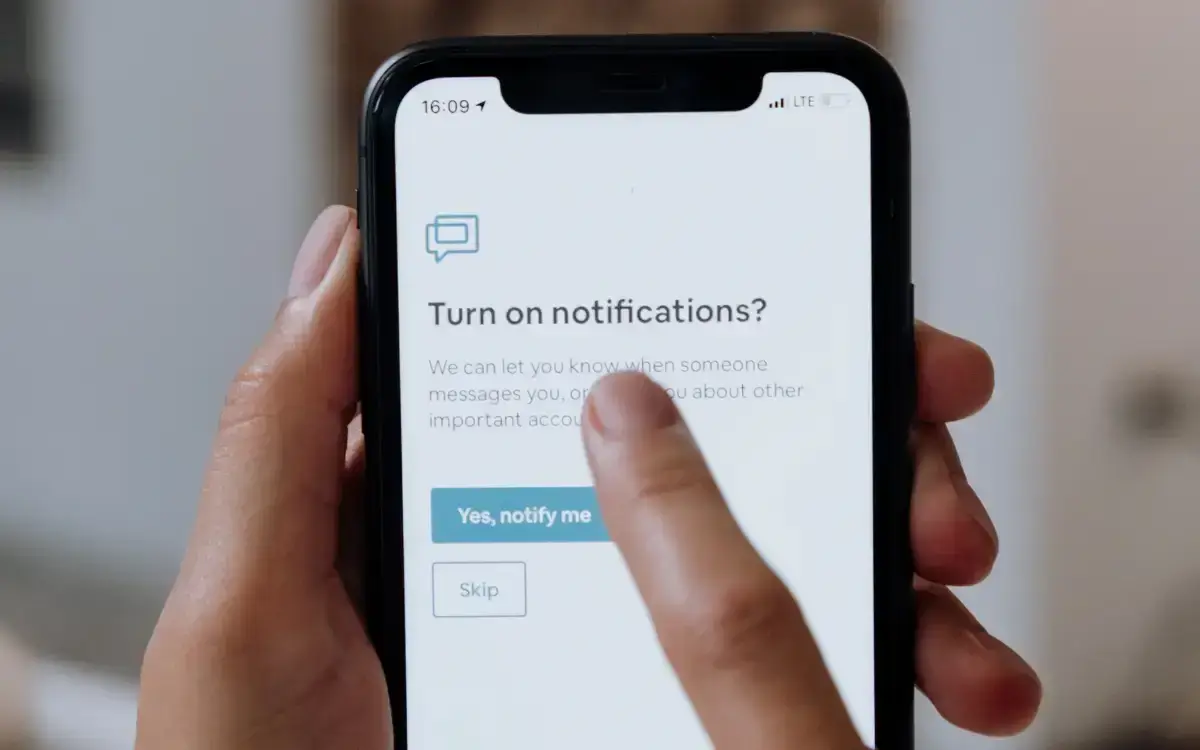In an age when we are all bombarded with different types of content, constantly connected through different social media and communication platforms, and, in a way, always available, users are certainly not looking forward to yet another push notification.
Nevertheless, push notifications have become an essential element of many businesses’ strategies, and those who don’t utilize them risk losing an important customer engagement channel.
However, it is possible to cut through the noise and avoid adding to the fatigue. Here are 10 push notification best practices to engage your audiences without compromising their user experience.
1. Be patient & avoid default permission requests
No matter how catchy and creative your push notifications are, they are completely worthless if users haven’t enabled you to send them.
So, rather than attacking new visitors with a default permission request the second they land on your website, wait a bit to establish some kind of a relationship.
Simply put, it’s much more likely that a user who has spent time on your page, keeps returning, or has made a purchase from your e-commerce will opt-in to receive communications, compared to someone who is visiting for the first time.
HoodEngage helps you solve this problem by allowing you to trigger permission requests based on different user interactions - from more straightforward ones, like On scroll and On click, to setting up different types of custom events to increase the chances of catching that perfect moment in which it will be most likely for the user to subscribe.
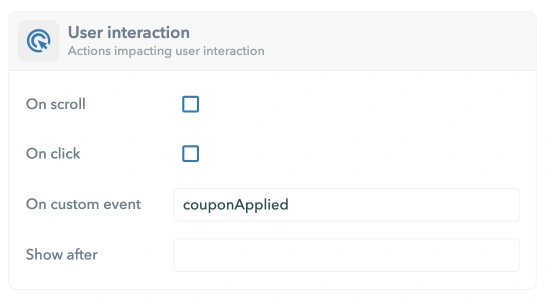
Custom prompt, User interaction options
The options for custom events are numerous - from purchase, video ended, form submitted, to wishlist added, checkout abandoned, etc. HoodEngage really gives you options to hyper-personalize communications with your customers.
2. Not everything is urgent or should be communicated to everyone
If you make every push communication seem urgent, users will eventually ignore it - just like the boy who cried “wolf”. Therefore, only create urgency when it’s “real”.
For example, announcing the last day or hour of a sale, or reminding customers that certain items will soon be out of stock, can effectively create a sense of urgency and capture users’ attention.
Furthermore, bear in mind that not every message needs to reach every user. A music app promoting rock concert tickets to users who exclusively listen to jazz would be a complete mismatch!
HoodEngage gives you the option to leverage detailed analytics and target users based on custom user data. Namely, by setting the key and value in such a way to understand that a user came from a path that clearly indicates an interest in jazz music, you can use that information later to target them based on that criterion.
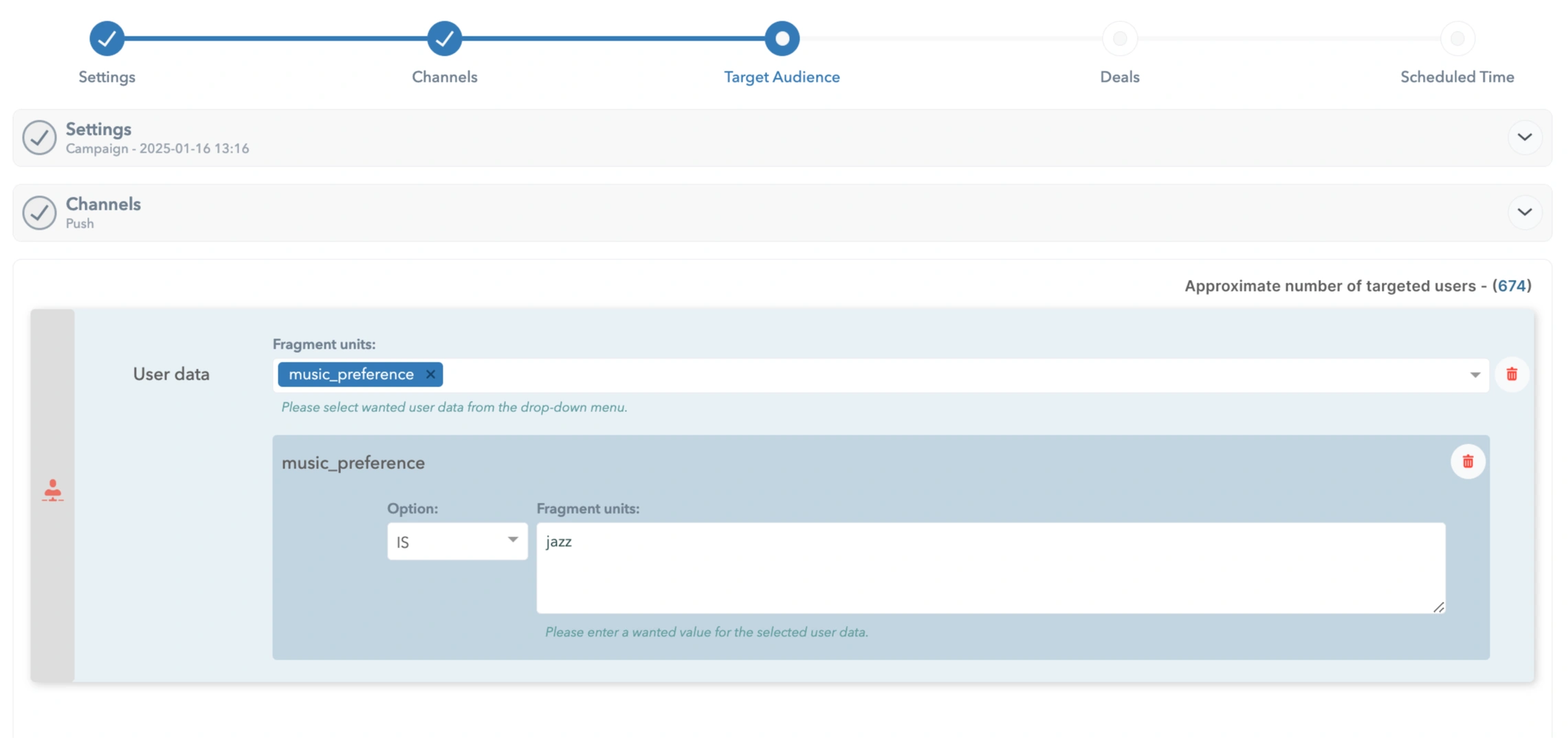
Custom user data option, target audience feature
3. Reach customers on their preferred channels
These days, there are so many ways to communicate, and people have all kinds of preferences. So, if your audience is all over the globe, uses different devices, and enjoys a mix of content, cross-channel communication is the way to go.
Cross-channel communication is the practice of interacting with customers across multiple channels or platforms, such as push notifications, SMS, email, social media, etc. to create a seamless and consistent experience at each step of your users’ journey.
This way, a business can reach users on their preferred channel and increase the likelihood of engagement, improve user experience, build trust, and raise the chances of conversion.
HoodEngage offers push notifications, SMS, and email, with the option to combine all three into a seamless engagement campaign thanks to its automated workflows through the Campaigns module.
4. A/B test everything. Or, at least - CTA buttons
Well, ok, maybe not everything, but it’s smart to test out different parts of your push message, especially the ones that play a crucial role in boosting customer engagement, such as - CTA buttons.
CTA buttons in push notifications are key elements that simplify user interaction and provide clear, direct paths to desired actions. The best (and fastest) way to identify the most effective ones is to A/B test them.
A/B testing is a popular experimentation process because it doesn’t require significant investments in terms of sample size, budget, or time, and therefore it allows you to gather and interpret results quickly. Briefly, in A/B testing two or more versions of a variable are shown to different segments of the same audience simultaneously to determine which option performs better.
The Campaigns module in HoodEngage we mentioned in the section above gives options to A/B test any part of your push message, CTA buttons included, in just a few clicks.
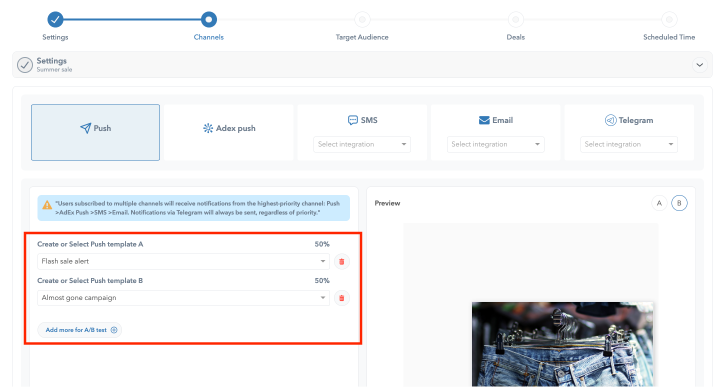
A/B testing, Campaigns
Once you know your audience better, it will be easier to make data-driven decisions and improve the potential for success of your campaign.
5. Take into consideration the timing
Timing is crucial not only for preventing notification fatigue but also for avoiding users from opting out of your communications entirely.
By following a few simple rules, your messages will be well timed, and consequently, more effective. So, make sure you:
Tone it down at certain hours
If your customer base spans across the globe, choose the push notification provider that supports scheduling notifications based on different time zones.
Nobody wants to be disturbed up in the middle of the night or woken up to a sea of notifications first thing in the morning.
Furthermore, make sure you’re not sending notifications at times that are completely out of context. Imagine a meal planning app sending a “Good morning, it’s time for a nutritious breakfast!” a message at 3 p.m (yikes!) - it doesn’t make your business look good.
Fine-tune the timing to fit your niche
Different industries perform better at certain times. For example, business and finance-related notifications tend to be more effective when sent in the morning, especially at the start of the week.
On the other hand, gaming and entertainment alerts are best reserved for evenings and weekends. A fitness app might focus on morning health tips, while meal planning notifications could arrive just before lunchtime.
Set it & forget it
All of the above can be planned and scheduled in advance to match user habits and hit the timings when users are most likely to engage.
HoodEngage offers a plethora of options to improve user experience while, at the same time, making sure that important communications are delivered at the most opportune hours.
For example, you can choose to run your campaigns by specific triggers - time, time patterns, webhook, or time intervals.
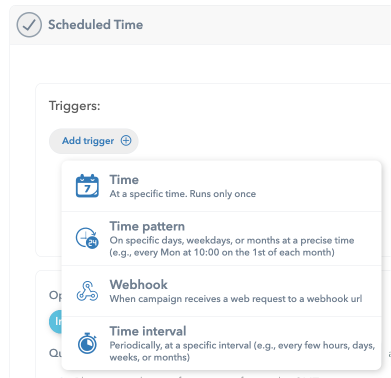
Advanced scheduling, Triggers option
Also, you can set quiet hours, automate time zone adjustments, set campaign dates, minimum number of runs, etc.
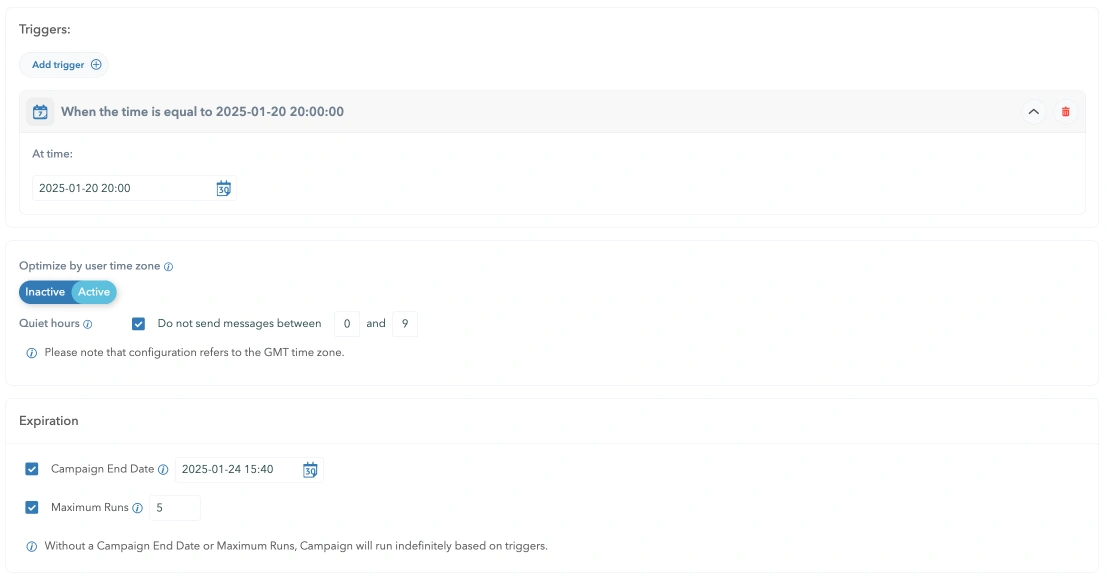
Advanced scheduling options
6. Track conversions with ease
Marketing attribution is the process of tracking user actions across various channels to determine which touchpoints are most effective in driving conversions.
Not tracking marketing attribution means that your engagement strategies are more of a “spray-and-pray” approach, and that you’re losing valuable time and money without even realizing it.
On the other hand, knowing exactly how your users behave, and setting personalized paths to success for each audience segment, can significantly improve conversions while allowing for better budget allocation and ROI increase.
For those purposes, HoodEngage offers 12 pricing models that can adapt to any business strategy unlike the ‘one-size-fits-all’ approach that doesn’t deliver such powerful results.
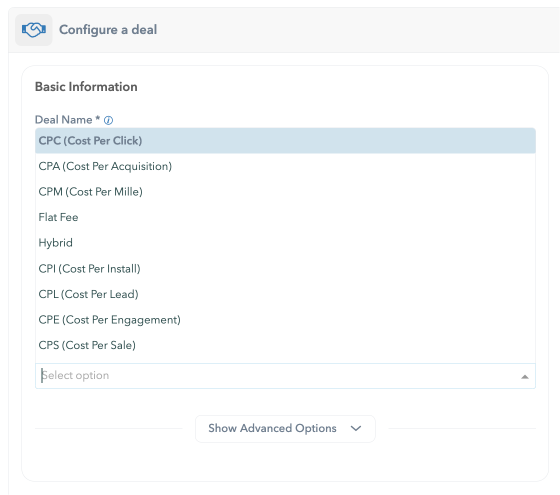
Conversion tracking pricing models, the Deals feature
Additionally, HoodEngage allows you to allocate budgets by country, device, and event, and therefore invest more in high-value conversions while reducing costs for less impactful interactions.
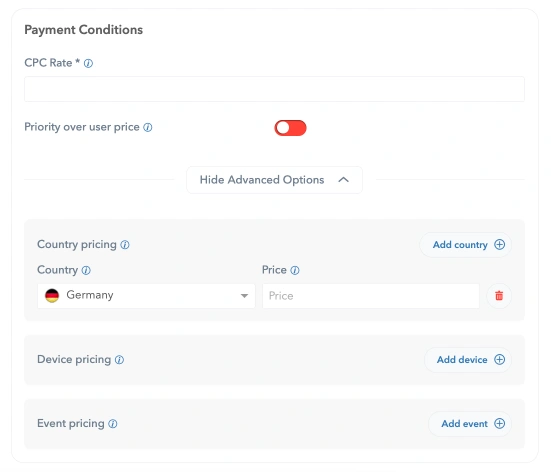
Deals payment conditions, advanced options
Lastly, HoodEngage delivers detailed information about conversion tracking and offers granular insight into user interactions across different channels.
7. Don’t make push notifications a one way communication
Don’t let push notifications become one-way communication. Instead of just prompting users to click, buy, or share, try to engage them in a meaningful dialogue. Ask for feedback: “How are we doing? Are the push notifications we’re sending relevant to you?”
This approach not only shows genuine care for your audience but also helps you learn what they might need that you’re not currently providing. Yes, it’s another ask, but this time, both sides can benefit—your customers feel heard, and you gain valuable insights to improve your service.
8. Give your users a pat on the back
Sometimes, it’s a good idea to take a break from asking and simply give your users a pat on the back.
While this practice may seem more intuitive for goal-oriented apps like fitness, running, or language learning apps, it can easily be applied to other sectors as well.
For example, financial apps can provide insights into how well users have managed their finances accompanied with encouraging messages such as “Congratulations, you’ve saved big this month!”, or a feedback app could let users know how helpful their reviews have been to others searching for similar services.
Incorporating these small gestures of positive reinforcement can make a big difference. Everyone appreciates a reminder that they’re doing something right, even if it comes from an app.
9. Less is more: Create crisp, powerful notifications
Push notifications, by nature, require brevity and precision in communication. To ensure that each message delivers maximum impact in minimal space, the format demands clarity, the use of power-words, and action-oriented language.
For many businesses, this can be a two-edged sword. On the one hand, it’s difficult to convey a message in around 100 characters, but on the other, it eliminates the fluff, and makes this format one of the most engaging ones.
Therefore, when writing push notification copy, bear in mind that every word counts. And don’t forget the impact of visuals!
10. Make your push pop: Use visuals & emojis
Push notifications with visual elements, like pictures and emojis, are more appealing because they quickly capture users’ attention in a cluttered digital space.
Visuals make the message more engaging and easier to understand at a glance, while emojis add a personal, relatable touch.
These elements break up the monotony of text-based notifications, making the communication feel more dynamic and memorable, which increases the likelihood of users interacting with the notification.
Ready to put these into practice? Start here
Choosing the right push notifications provider can impact your communications strategy on so many levels - from automating certain steps to offering many options for personalization and more efficient delivery.
To check how HoodEngage can help nail your push notifications game plan, test it our for FREE, or get a live, 1-on-1 demo with one of our account executives.
Take a first step on your path to success today!
![10 push notification best practices [2025]](/images/resources/blog/blog-release/push-best-practices/cover-blog-push-best-practice.webp)

